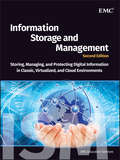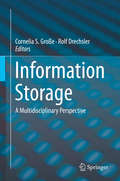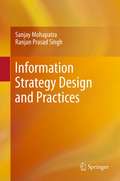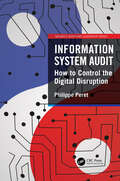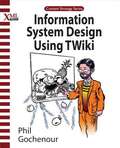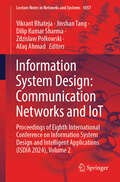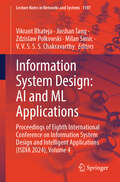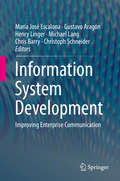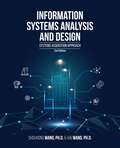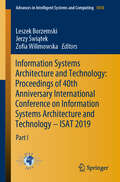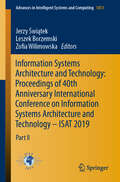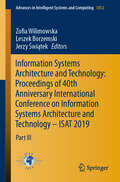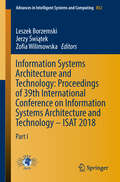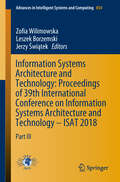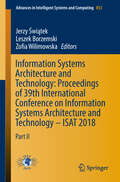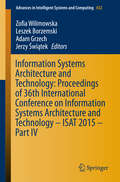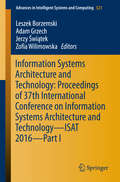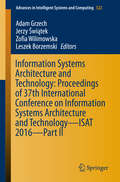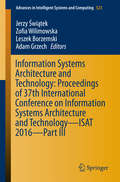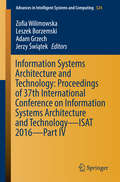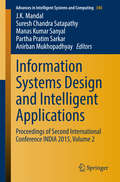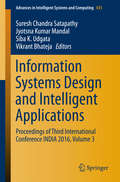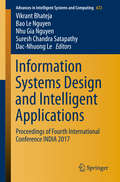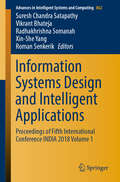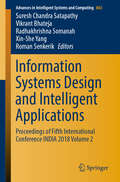- Table View
- List View
Information Storage and Management: Storing, Managing, and Protecting Digital Information in Classic, Virtualized, and Cloud Environments
by Emc Education ServicesThe new edition of a bestseller, now revised and update throughout! This new edition of the unparalleled bestseller serves as a full training course all in one and as the world's largest data storage company, EMC is the ideal author for such a critical resource. They cover the components of a storage system and the different storage system models while also offering essential new material that explores the advances in existing technologies and the emergence of the "Cloud" as well as updates and vital information on new technologies. Features a separate section on emerging area of cloud computing Covers new technologies such as: data de-duplication, unified storage, continuous data protection technology, virtual provisioning, FCoE, flash drives, storage tiering, big data, and more Details storage models such as Network Attached Storage (NAS), Storage Area Network (SAN), Object Based Storage along with virtualization at various infrastructure components Explores Business Continuity and Security in physical and virtualized environment Includes an enhanced Appendix for additional information This authoritative guide is essential for getting up to speed on the newest advances in information storage and management.
Information Storage: A Multidisciplinary Perspective
by Rolf Drechsler Cornelia S. GroßeThis book examines some of the underlying processes behind different forms of information management, including how we store information in our brains, the impact of new technologies such as computers and robots on our efficiency in storing information, and how information is stored in families and in society. The editors brought together experts from a variety of disciplines. While it is generally agreed that information reduces uncertainties and that the ability to store it safely is of vital importance, these authors are open to different meanings of “information”: computer science considers the bit as the information block; neuroscience emphasizes the importance of information as sensory inputs that are processed and transformed in the brain; theories in psychology focus more on individual learning and on the acquisition of knowledge; and finally sociology looks at how interpersonal processes within groups or society itself come to the fore. The book will be of value to researchers and students in the areas of information theory, artificial intelligence, and computational neuroscience.
Information Strategy Design and Practices
by Ranjan Prasad Singh Sanjay MohapatraInformation Strategy Design and Practices develops a framework for designing information technology strategy for an organization. Beyond this, it establishes an approach to not only implement it, but sustain it. The framework explains how IT strategy should have an alignment to business to reap the benefits of business. The book contains five case studies in different domains: retail, real estate development, IT product development, development sector, and education sector. These case studies have been applied to different countries, providing a global prospective to this emerging trend.
Information System Audit: How to Control the Digital Disruption (Security, Audit and Leadership Series)
by Philippe PeretThe digitalization of companies is a recurrent topic of conversation for managers. Companies are forced to evolve at least as fast as their competitors. They have to review their organization, their processes, and their way of working. This also concerns auditors in terms of their audit strategy and working methods. Digitalization is the tip of the iceberg that represents the increasing reliance on information technology of the company’s information system. Companies have seen new competitors succeed with a digital approach, competitors that have opened new markets or new ways of interacting with their customers, and all business processes can be digitalized. In this new paradigm, auditors have to renew themselves too. Long gone are the days of auditors specializing in one technique, like financial auditors or IT auditors. This makes it a phenomenal opportunity for auditing to renew itself, embracing the vision of the company’s information system: long live the information system auditors! This book proposes you to go step by step from a common understanding of our history of auditing to gradually defining and justifying the impacts of digitalization on the audit strategy and the preparation of audits.
Information System Design Using Twiki
by Phillip GochenourPhil Gochenour combines real-world experience designing enterprise information systems with a veteran teacher's ability to explain the basic principles behind any system design, whether it's a cookbook or a software company's wiki. Information System Design Using TWiki takes the reader through a step-by-step project starting with the basic building block of all information systems, the topic, and continuing with sections on metadata, search systems, and usability. The companion website provides sample code that can be used to construct the complete project on the TWiki wiki platform, making it possible for readers to understand TWiki's functionality and potential while constructing a usable system. Whether you are looking for a way to learn the basics of information system design, or you work with TWiki and want to learn how to use it more effectively, this book is for you.
Information System Design: Proceedings of Eighth International Conference on Information System Design and Intelligent Applications (ISDIA 2024), Volume 2 (Lecture Notes in Networks and Systems #1057)
by Vikrant Bhateja Dilip Kumar Sharma Zdzislaw Polkowski Jinshan Tang Afaq AhmadThis book presents a collection of high-quality, peer-reviewed research papers from the 8th International Conference on Information System Design and Intelligent Applications (ISDIA 2024), held in Dubai, UAE, from 3 - 4 January 2024. It covers a wide range of topics in computer science and information technology, including data mining and data warehousing, high-performance computing, parallel and distributed computing, computational intelligence, soft computing, big data, cloud computing, grid computing, cognitive computing, and information security.
Information System Design: Proceedings of Eighth International Conference on Information System Design and Intelligent Applications (ISDIA 2024), Volume 4 (Lecture Notes in Networks and Systems #1107)
by Vikrant Bhateja Zdzislaw Polkowski Milan Simic V. V. S. S. S. Chakravarthy Jinshan TangThis book presents a collection of high-quality, peer-reviewed research papers from the 8th International Conference on Information System Design and Intelligent Applications (ISDIA 2024), held in Dubai, UAE, from 3 - 4 January 2024. It covers a wide range of topics in computer science and information technology, including data mining and data warehousing, high-performance computing, parallel and distributed computing, computational intelligence, soft computing, big data, cloud computing, grid computing, cognitive computing, and information security.
Information System Development: Improving Enterprise Communication
by Michael Lang Christoph Schneider Chris Barry Henry Linger María José Escalona Gustavo AragónInformation System Development--Improving Enterprise Communication are the collected proceedings of the 22nd International Conference on Information Systems Development: Improving Enterprise Communication--ISD 2013 Conference, held in Seville, Spain. It follows in the tradition of previous conferences in the series in exploring the connections between industry, research and education. These proceedings represent ongoing reflections within the academic community on established information systems topics and emerging concepts, approaches and ideas. It is hoped that the papers herein contribute towards disseminating research and improving practice. The conference tracks highlighted at the 22nd International Conference on Information Systems Development (ISD 2013) were: Applications Data and Ontologies End Users Enterprise Evolution Industrial cases in ISD Intelligent Business Process Management Model Driven Engineering in ISD New Technologies Process Management Quality
Information Systems Analysis and Design (2nd Edition): Systems Acquisition Approach
by Wang Shouhong WangInformation Systems Analysis and Design presents essential knowledge about management information systems development. It is used for four-year university and college students who study information systems analysis and design. Students will lea
Information Systems Architecture and Technology: Part I (Advances in Intelligent Systems and Computing #1050)
by Jerzy Świątek Leszek Borzemski Zofia WilimowskaThis three-volume book highlights significant advances in the development of new information systems technologies and architectures. Further, it helps readers solve specific research and analytical problems and glean useful knowledge and business value from data. Each chapter provides an analysis of a specific technical problem, followed by a numerical analysis, simulation, and implementation of the solution to the real-world problem. Managing an organization, especially in today’s rapidly changing environment, is a highly complex process. Increased competition in the marketplace, especially as a result of the massive and successful entry of foreign businesses into domestic markets, changes in consumer behaviour, and broader access to new technologies and information, calls for organisational restructuring and the introduction and modification of management methods using the latest scientific advances. This situation has prompted various decision-making bodies to introduce computer modelling of organization management systems. This book presents the peer-reviewed proceedings of the 40th Anniversary International Conference “Information Systems Architecture and Technology” (ISAT), held on September 15–17, 2019, in Wrocław, Poland. The conference was organised by the Computer Science Department, Faculty of Computer Science and Management, Wroclaw University of Sciences and Technology, and University of Applied Sciences in Nysa, Poland. The papers have been grouped into three major sections: Part I—discusses topics including, but not limited to, artificial intelligence methods, knowledge discovery and data mining, big data, knowledge-based management, Internet of Things, cloud computing and high-performance computing, distributed computer systems, content delivery networks, and service-oriented computing. Part II—addresses various topics, such as system modelling for control, recognition and decision support, mathematical modelling in computer system design, service-oriented systems, and cloud computing, and complex process modelling. Part III—focuses on a number of themes, like knowledge-based management, modelling of financial and investment decisions, modelling of managerial decisions, production systems management, and maintenance, risk management, small business management, and theories and models of innovation.
Information Systems Architecture and Technology: Part II (Advances in Intelligent Systems and Computing #1051)
by Jerzy Świątek Leszek Borzemski Zofia WilimowskaThis three-volume book highlights significant advances in the development of new information systems technologies and architectures. Further, it helps readers solve specific research and analytical problems and glean useful knowledge and business value from data. Each chapter provides an analysis of a specific technical problem, followed by a numerical analysis, simulation, and implementation of the solution to the real-world problem.Managing an organization, especially in today’s rapidly changing environment, is a highly complex process. Increased competition in the marketplace, especially as a result of the massive and successful entry of foreign businesses into domestic markets, changes in consumer behaviour, and broader access to new technologies and information, calls for organisational restructuring and the introduction and modification of management methods using the latest scientific advances. This situation has prompted various decision-making bodies to introduce computer modelling of organization management systems.This book presents the peer-reviewed proceedings of the 40th Anniversary International Conference “Information Systems Architecture and Technology” (ISAT), held on September 15–17, 2019, in Wrocław, Poland. The conference was organised by the Computer Science Department, Faculty of Computer Science and Management, Wroclaw University of Sciences and Technology, and University of Applied Sciences in Nysa, Poland. The papers have been grouped into three major sections:Part I—discusses topics including, but not limited to, artificial intelligence methods, knowledge discovery and data mining, big data, knowledge-based management, Internet of Things, cloud computing and high-performance computing, distributed computer systems, content delivery networks, and service-oriented computing.Part II—addresses various topics, such as system modelling for control, recognition and decision support, mathematical modelling in computer system design, service-oriented systems, and cloud computing, and complex process modelling.Part III—focuses on a number of themes, like knowledge-based management, modelling of financial and investment decisions, modelling of managerial decisions, production systems management, and maintenance, risk management, small business management, and theories and models of innovation.
Information Systems Architecture and Technology: Part III (Advances in Intelligent Systems and Computing #1052)
by Jerzy Świątek Leszek Borzemski Zofia WilimowskaThis three-volume book highlights significant advances in the development of new information systems technologies and architectures. Further, it helps readers solve specific research and analytical problems and glean useful knowledge and business value from data. Each chapter provides an analysis of a specific technical problem, followed by a numerical analysis, simulation, and implementation of the solution to the real-world problem.Managing an organization, especially in today’s rapidly changing environment, is a highly complex process. Increased competition in the marketplace, especially as a result of the massive and successful entry of foreign businesses into domestic markets, changes in consumer behaviour, and broader access to new technologies and information, calls for organisational restructuring and the introduction and modification of management methods using the latest scientific advances. This situation has prompted various decision-making bodies to introduce computer modelling of organization management systems.This book presents the peer-reviewed proceedings of the 40th Anniversary International Conference “Information Systems Architecture and Technology” (ISAT), held on September 15–17, 2019, in Wrocław, Poland. The conference was organised by the Computer Science Department, Faculty of Computer Science and Management, Wroclaw University of Sciences and Technology, and University of Applied Sciences in Nysa, Poland. The papers have been grouped into three major sections:Part I—discusses topics including, but not limited to, artificial intelligence methods, knowledge discovery and data mining, big data, knowledge-based management, Internet of Things, cloud computing and high-performance computing, distributed computer systems, content delivery networks, and service-oriented computing.Part II—addresses various topics, such as system modelling for control, recognition and decision support, mathematical modelling in computer system design, service-oriented systems, and cloud computing, and complex process modelling.Part III—focuses on a number of themes, like knowledge-based management, modelling of financial and investment decisions, modelling of managerial decisions, production systems management, and maintenance, risk management, small business management, and theories and models of innovation.
Information Systems Architecture and Technology: Part Iii (Advances In Intelligent Systems and Computing #854)
by Jerzy Świątek Leszek Borzemski Zofia WilimowskaThis three-volume set of books highlights major advances in the development of concepts and techniques in the area of new technologies and architectures of contemporary information systems. Further, it helps readers solve specific research and analytical problems and glean useful knowledge and business value from the data. Each chapter provides an analysis of a specific technical problem, followed by a numerical analysis, simulation and implementation of the solution to the real-life problem. Managing an organisation, especially in today’s rapidly changing circumstances, is a very complex process. Increased competition in the marketplace, especially as a result of the massive and successful entry of foreign businesses into domestic markets, changes in consumer behaviour, and broader access to new technologies and information, calls for organisational restructuring and the introduction and modification of management methods using the latest advances in science. This situation has prompted many decision-making bodies to introduce computer modelling of organisation management systems. The three books present the peer-reviewed proceedings of the 39th International Conference “Information Systems Architecture and Technology” (ISAT), held on September 16–18, 2018 in Nysa, Poland. The conference was organised by the Computer Science and Management Systems Departments, Faculty of Computer Science and Management, Wroclaw University of Technology and Sciences and University of Applied Sciences in Nysa, Poland. The papers have been grouped into three major parts: Part I—discusses topics including but not limited to Artificial Intelligence Methods, Knowledge Discovery and Data Mining, Big Data, Knowledge Based Management, Internet of Things, Cloud Computing and High Performance Computing, Distributed Computer Systems, Content Delivery Networks, and Service Oriented Computing. Part II—addresses topics including but not limited to System Modelling for Control, Recognition and Decision Support, Mathematical Modelling in Computer System Design, Service Oriented Systems and Cloud Computing, and Complex Process Modelling. Part III—focuses on topics including but not limited to Knowledge Based Management, Modelling of Financial and Investment Decisions, Modelling of Managerial Decisions, Production Systems Management and Maintenance, Risk Management, Small Business Management, and Theories and Models of Innovation.
Information Systems Architecture and Technology: Part Iii (Advances In Intelligent Systems and Computing #854)
by Jerzy Świątek Leszek Borzemski Zofia WilimowskaThis three-volume set of books highlights major advances in the development of concepts and techniques in the area of new technologies and architectures of contemporary information systems. Further, it helps readers solve specific research and analytical problems and glean useful knowledge and business value from the data. Each chapter provides an analysis of a specific technical problem, followed by a numerical analysis, simulation and implementation of the solution to the real-life problem. Managing an organisation, especially in today’s rapidly changing circumstances, is a very complex process. Increased competition in the marketplace, especially as a result of the massive and successful entry of foreign businesses into domestic markets, changes in consumer behaviour, and broader access to new technologies and information, calls for organisational restructuring and the introduction and modification of management methods using the latest advances in science. This situation has prompted many decision-making bodies to introduce computer modelling of organisation management systems. The three books present the peer-reviewed proceedings of the 39th International Conference “Information Systems Architecture and Technology” (ISAT), held on September 16–18, 2018 in Nysa, Poland. The conference was organised by the Computer Science and Management Systems Departments, Faculty of Computer Science and Management, Wroclaw University of Technology and Sciences and University of Applied Sciences in Nysa, Poland. The papers have been grouped into three major parts: Part I—discusses topics including but not limited to Artificial Intelligence Methods, Knowledge Discovery and Data Mining, Big Data, Knowledge Based Management, Internet of Things, Cloud Computing and High Performance Computing, Distributed Computer Systems, Content Delivery Networks, and Service Oriented Computing. Part II—addresses topics including but not limited to System Modelling for Control, Recognition and Decision Support, Mathematical Modelling in Computer System Design, Service Oriented Systems and Cloud Computing, and Complex Process Modelling. Part III—focuses on topics including but not limited to Knowledge Based Management, Modelling of Financial and Investment Decisions, Modelling of Managerial Decisions, Production Systems Management and Maintenance, Risk Management, Small Business Management, and Theories and Models of Innovation.
Information Systems Architecture and Technology: Part Iii (Advances In Intelligent Systems and Computing #854)
by Jerzy Świątek Leszek Borzemski Zofia WilimowskaThis three-volume set of books highlights major advances in the development of concepts and techniques in the area of new technologies and architectures of contemporary information systems. Further, it helps readers solve specific research and analytical problems and glean useful knowledge and business value from the data. Each chapter provides an analysis of a specific technical problem, followed by a numerical analysis, simulation and implementation of the solution to the real-life problem. Managing an organisation, especially in today’s rapidly changing circumstances, is a very complex process. Increased competition in the marketplace, especially as a result of the massive and successful entry of foreign businesses into domestic markets, changes in consumer behaviour, and broader access to new technologies and information, calls for organisational restructuring and the introduction and modification of management methods using the latest advances in science. This situation has prompted many decision-making bodies to introduce computer modelling of organisation management systems. The three books present the peer-reviewed proceedings of the 39th International Conference “Information Systems Architecture and Technology” (ISAT), held on September 16–18, 2018 in Nysa, Poland. The conference was organised by the Computer Science and Management Systems Departments, Faculty of Computer Science and Management, Wroclaw University of Technology and Sciences and University of Applied Sciences in Nysa, Poland. The papers have been grouped into three major parts: Part I—discusses topics including but not limited to Artificial Intelligence Methods, Knowledge Discovery and Data Mining, Big Data, Knowledge Based Management, Internet of Things, Cloud Computing and High Performance Computing, Distributed Computer Systems, Content Delivery Networks, and Service Oriented Computing. Part II—addresses topics including but not limited to System Modelling for Control, Recognition and Decision Support, Mathematical Modelling in Computer System Design, Service Oriented Systems and Cloud Computing, and Complex Process Modelling. Part III—focuses on topics including but not limited to Knowledge Based Management, Modelling of Financial and Investment Decisions, Modelling of Managerial Decisions, Production Systems Management and Maintenance, Risk Management, Small Business Management, and Theories and Models of Innovation.
Information Systems Architecture and Technology: Proceedings of 36th International Conference on Information Systems Architecture and Technology - ISAT 2015 - Part III
by Jerzy Świątek Leszek Borzemski Adam Grzech Zofia WilimowskaThis fourvolume set of books constitutes the proceedings of the 36th InternationalConference Information Systems Architecture and Technology 2015, or ISAT 2015for short, held on September 20-22, 2015 in Karpacz, Poland. The conference wasorganized by the Computer Science and Management Systems Departments, Facultyof Computer Science and Management, Wroclaw University of Technology, Poland. The papers included in the proceedings have been subject to a thorough reviewprocess by highly qualified peer reviewers. The accepted papers have beengrouped into four parts: Part I--addressing topics including,but not limited to, systems analysis and modeling, methods for managing complexplanning environment and insights from Big Data research projects. Part II--discoursing about topicsincluding, but not limited to, Web systems, computer networks, distributedcomputing, and multi-agent systems and Internet of Things. Part III--discussing topics including,but not limited to, mobile and Service Oriented Architecture systems, highperformance computing, cloud computing, knowledge discovery, data mining andknowledge based management. Part IV--dealing with topicsincluding, but not limited to, finance, logistics and market problems, andartificial intelligence methods.
Information Systems Architecture and Technology: Proceedings of 37th International Conference on Information Systems Architecture and Technology – ISAT 2016 – Part I
by Jerzy Świątek Leszek Borzemski Adam Grzech Zofia WilimowskaThis four volume set of books constitutes the proceedings of the 2016 37th International Conference Information Systems Architecture and Technology (ISAT), or ISAT 2016 for short, held on September 18-20, 2016 in Karpacz, Poland. The conference was organized by the Department of Management Systems and the Department of Computer Science, Wrocław University of Science and Technology, Poland. The papers included in the proceedings have been subject to a thorough review process by highly qualified peer reviewers. The accepted papers have been grouped into four parts: Part I--addressing topics including, but not limited to, systems analysis and modeling, methods for managing complex planning environment and insights from Big Data research projects. Part II--discoursing about topics including, but not limited to, Web systems, computer networks, distributed computing, and mulit-agent systems and Internet of Things. Part III--discussing topics including, but not limited to, mobile and Service Oriented Architecture systems, high performance computing, cloud computing, knowledge discovery, data mining and knowledge based management. Part IV--dealing with topics including, but not limited to, finance, logistics and market problems, and artificial intelligence methods.
Information Systems Architecture and Technology: Proceedings of 37th International Conference on Information Systems Architecture and Technology – ISAT 2016 – Part II
by Jerzy Świątek Leszek Borzemski Adam Grzech Zofia WilimowskaThis four volume set of books constitutes the proceedings of the 2016 37th International Conference Information Systems Architecture and Technology (ISAT), or ISAT 2016 for short, held on September 18-20, 2016 in Karpacz, Poland. The conference was organized by the Department of Management Systems and the Department of Computer Science, Wrocław University of Science and Technology, Poland. The papers included in the proceedings have been subject to a thorough review process by highly qualified peer reviewers. The accepted papers have been grouped into four parts: Part I--addressing topics including, but not limited to, systems analysis and modeling, methods for managing complex planning environment and insights from Big Data research projects. Part II--discoursing about topics including, but not limited to, Web systems, computer networks, distributed computing, and mulit-agent systems and Internet of Things. Part III--discussing topics including, but not limited to, mobile and Service Oriented Architecture systems, high performance computing, cloud computing, knowledge discovery, data mining and knowledge based management. Part IV--dealing with topics including, but not limited to, finance, logistics and market problems, and artificial intelligence methods.
Information Systems Architecture and Technology: Proceedings of 37th International Conference on Information Systems Architecture and Technology – ISAT 2016 – Part III
by Jerzy Świątek Leszek Borzemski Adam Grzech Zofia WilimowskaThis four volume set of books constitutes the proceedings of the 2016 37th International Conference Information Systems Architecture and Technology (ISAT), or ISAT 2016 for short, held on September 18-20, 2016 in Karpacz, Poland. The conference was organized by the Department of Management Systems and the Department of Computer Science, Wrocław University of Science and Technology, Poland. The papers included in the proceedings have been subject to a thorough review process by highly qualified peer reviewers. The accepted papers have been grouped into four parts: Part I--addressing topics including, but not limited to, systems analysis and modeling, methods for managing complex planning environment and insights from Big Data research projects. Part II--discoursing about topics including, but not limited to, Web systems, computer networks, distributed computing, and mulit-agent systems and Internet of Things. Part III--discussing topics including, but not limited to, mobile and Service Oriented Architecture systems, high performance computing, cloud computing, knowledge discovery, data mining and knowledge based management. Part IV--dealing with topics including, but not limited to, finance, logistics and market problems, and artificial intelligence methods.
Information Systems Architecture and Technology: Proceedings of 37th International Conference on Information Systems Architecture and Technology – ISAT 2016 – Part IV
by Jerzy Świątek Leszek Borzemski Adam Grzech Zofia WilimowskaThis four volume set of books constitutes the proceedings of the 2016 37th International Conference Information Systems Architecture and Technology (ISAT), or ISAT 2016 for short, held on September 18-20, 2016 in Karpacz, Poland. The conference was organized by the Department of Management Systems and the Department of Computer Science, Wrocław University of Science and Technology, Poland. The papers included in the proceedings have been subject to a thorough review process by highly qualified peer reviewers. The accepted papers have been grouped into four parts: Part I--addressing topics including, but not limited to, systems analysis and modeling, methods for managing complex planning environment and insights from Big Data research projects. Part II--discoursing about topics including, but not limited to, Web systems, computer networks, distributed computing, and multi-agent systems and Internet of Things. Part III--discussing topics including, but not limited to, mobile and Service Oriented Architecture systems, high performance computing, cloud computing, knowledge discovery, data mining and knowledge based management. Part IV--dealing with topics including, but not limited to, finance, logistics and market problems, and artificial intelligence methods.
Information Systems Design and Intelligent Applications
by Anirban Mukhopadhyay Suresh Chandra Satapathy J. K. Mandal Manas Kumar Sanyal Partha Pratim SarkarThe second international conference on INformation Systems Design and Intelligent Applications (INDIA - 2015) held in Kalyani, India during January 8-9, 2015. The book covers all aspects of information system design, computer science and technology, general sciences, and educational research. Upon a double blind review process, a number of high quality papers are selected and collected in the book, which is composed of two different volumes, and covers a variety of topics, including natural language processing, artificial intelligence, security and privacy, communications, wireless and sensor networks, microelectronics, circuit and systems, machine learning, soft computing, mobile computing and applications, cloud computing, software engineering, graphics and image processing, rural engineering, e-commerce, e-governance, business computing, molecular computing, nano-computing, chemical computing, intelligent computing for GIS and remote sensing, bio-informatics and bio-computing. These fields are not only limited to computer researchers but also include mathematics, chemistry, biology, bio-chemistry, engineering, statistics, and all others in which computer techniques may assist.
Information Systems Design and Intelligent Applications
by Suresh Chandra Satapathy Jyotsna Kumar Mandal Vikrant Bhateja Siba K. UdgataThethird international conference on INformation Systems Design and IntelligentApplications (INDIA - 2016) held in Visakhapatnam, India during January 8-9,2016. The book covers all aspects of information system design, computerscience and technology, general sciences, and educational research. Upon adouble blind review process, a number of high quality papers are selected andcollected in the book, which is composed of three different volumes, and coversa variety of topics, including natural language processing, artificialintelligence, security and privacy, communications, wireless and sensornetworks, microelectronics, circuit and systems, machine learning, softcomputing, mobile computing and applications, cloud computing, software engineering,graphics and image processing, rural engineering, e-commerce, e-governance,business computing, molecular computing, nano-computing, chemical computing,intelligent computing for GIS and remote sensing, bio-informatics andbio-computing. These fields are not only limited to computer researchers butalso include mathematics, chemistry, biology, bio-chemistry, engineering,statistics, and all others in which computer techniques may assist.
Information Systems Design and Intelligent Applications: Proceedings Of Fourth International Conference India 2017 (Advances In Intelligent Systems And Computing #672)
by Suresh Chandra Satapathy Vikrant Bhateja Bao Le Nguyen Nhu Gia Nguyen Dac-Nhuong LeThe book is a collection of high-quality peer-reviewed research papers presented at International Conference on Information System Design and Intelligent Applications (INDIA 2017) held at Duy Tan University, Da Nang, Vietnam during 15-17 June 2017. The book covers a wide range of topics of computer science and information technology discipline ranging from image processing, database application, data mining, grid and cloud computing, bioinformatics and many others. The various intelligent tools like swarm intelligence, artificial intelligence, evolutionary algorithms, bio-inspired algorithms have been well applied in different domains for solving various challenging problems.
Information Systems Design and Intelligent Applications: Proceedings Of Fourth International Conference India 2017 (Advances in Intelligent Systems and Computing #672)
by Xin-She Yang Roman Senkerik Suresh Chandra Satapathy Vikrant Bhateja Radhakhrishna SomanahThe third international conference on INformation Systems Design and Intelligent Applications (INDIA – 2016) held in Visakhapatnam, India during January 8-9, 2016. The book covers all aspects of information system design, computer science and technology, general sciences, and educational research. Upon a double blind review process, a number of high quality papers are selected and collected in the book, which is composed of three different volumes, and covers a variety of topics, including natural language processing, artificial intelligence, security and privacy, communications, wireless and sensor networks, microelectronics, circuit and systems, machine learning, soft computing, mobile computing and applications, cloud computing, software engineering, graphics and image processing, rural engineering, e-commerce, e-governance, business computing, molecular computing, nano-computing, chemical computing, intelligent computing for GIS and remote sensing, bio-informatics and bio-computing. These fields are not only limited to computer researchers but also include mathematics, chemistry, biology, bio-chemistry, engineering, statistics, and all others in which computer techniques may assist.
Information Systems Design and Intelligent Applications: Proceedings of Fifth International Conference INDIA 2018 Volume 2 (Communications in Computer and Information Science #863)
by Xin-She Yang Roman Senkerik Suresh Chandra Satapathy Vikrant Bhateja Radhakhrishna SomanahThe book gathers a collection of high-quality peer-reviewed research papers presented at the International Conference on Information System Design and Intelligent Applications (INDIA 2018), which was held at the Universite des Mascareignes, Mauritius from July 19 to 21, 2018. It covers a wide range of topics in computer science and information technology, from image processing, database applications and data mining, to grid and cloud computing, bioinformatics and many more. The intelligent tools discussed, e.g. swarm intelligence, artificial intelligence, evolutionary algorithms, and bio-inspired algorithms, are currently being applied to solve challenging problems in various domains.
